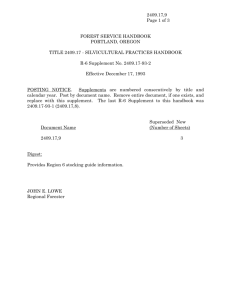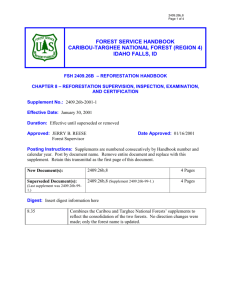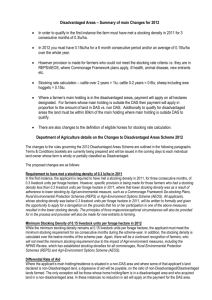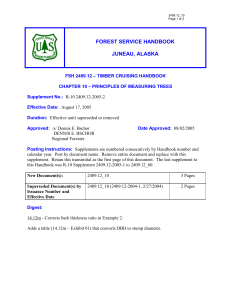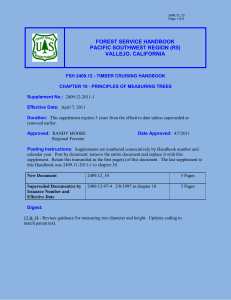r1-2409.17_9_9.04d
advertisement
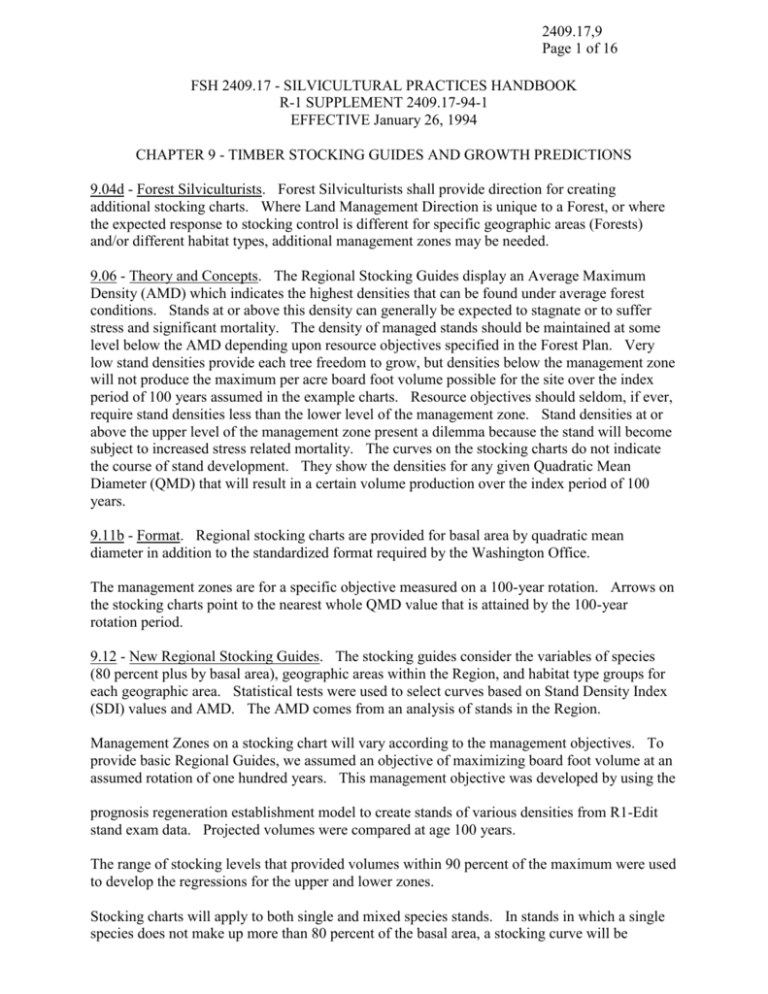
2409.17,9 Page 1 of 16 FSH 2409.17 - SILVICULTURAL PRACTICES HANDBOOK R-1 SUPPLEMENT 2409.17-94-1 EFFECTIVE January 26, 1994 CHAPTER 9 - TIMBER STOCKING GUIDES AND GROWTH PREDICTIONS 9.04d - Forest Silviculturists. Forest Silviculturists shall provide direction for creating additional stocking charts. Where Land Management Direction is unique to a Forest, or where the expected response to stocking control is different for specific geographic areas (Forests) and/or different habitat types, additional management zones may be needed. 9.06 - Theory and Concepts. The Regional Stocking Guides display an Average Maximum Density (AMD) which indicates the highest densities that can be found under average forest conditions. Stands at or above this density can generally be expected to stagnate or to suffer stress and significant mortality. The density of managed stands should be maintained at some level below the AMD depending upon resource objectives specified in the Forest Plan. Very low stand densities provide each tree freedom to grow, but densities below the management zone will not produce the maximum per acre board foot volume possible for the site over the index period of 100 years assumed in the example charts. Resource objectives should seldom, if ever, require stand densities less than the lower level of the management zone. Stand densities at or above the upper level of the management zone present a dilemma because the stand will become subject to increased stress related mortality. The curves on the stocking charts do not indicate the course of stand development. They show the densities for any given Quadratic Mean Diameter (QMD) that will result in a certain volume production over the index period of 100 years. 9.11b - Format. Regional stocking charts are provided for basal area by quadratic mean diameter in addition to the standardized format required by the Washington Office. The management zones are for a specific objective measured on a 100-year rotation. Arrows on the stocking charts point to the nearest whole QMD value that is attained by the 100-year rotation period. 9.12 - New Regional Stocking Guides. The stocking guides consider the variables of species (80 percent plus by basal area), geographic areas within the Region, and habitat type groups for each geographic area. Statistical tests were used to select curves based on Stand Density Index (SDI) values and AMD. The AMD comes from an analysis of stands in the Region. Management Zones on a stocking chart will vary according to the management objectives. To provide basic Regional Guides, we assumed an objective of maximizing board foot volume at an assumed rotation of one hundred years. This management objective was developed by using the prognosis regeneration establishment model to create stands of various densities from R1-Edit stand exam data. Projected volumes were compared at age 100 years. The range of stocking levels that provided volumes within 90 percent of the maximum were used to develop the regressions for the upper and lower zones. Stocking charts will apply to both single and mixed species stands. In stands in which a single species does not make up more than 80 percent of the basal area, a stocking curve will be R1 SUPPLEMENT 2409.17-94-1 EFFECTIVE 1/26/94 2409.17,9 Page 2 of 16 selected based on the species that will be favored to leave in cultural operations. Three figures are provided for each stocking chart; two on the standard format, and one Basal Area over QMD. As it is difficult to interpolate for small QMDs from the figures, a table is provided for the number of trees per acre for QMDs of 1 through 3 inches. REGIONAL STOCKING CHARTS - White pine - Larch - Idaho: Douglas-fir, habitat type group #1 - Idaho: Douglas-fir, habitat type group #2 - W. Montana: Douglas-fir, habitat type group #1 - W. Montana: Douglas-fir, habitat type group #2 - W. Montana: Douglas-fir, habitat type group #3 - Eastern Montana: Douglas-fir - Grand fir - Western Hemlock - Cedar, habitat type group #1 - Cedar, habitat type group #2 - Idaho/Western Montana: lodgepole pine - Eastern Montana: lodgepole pine - Spruce - Idaho: Subalpine fir - Montana: Subalpine fir, habitat type group #1 - Montana: Subalpine fir, habitat type group #2 - Ponderosa pine Appendix A Appendix B Appendix C Appendix D Appendix E Appendix F Appendix G Appendix H Appendix I Appendix J Appendix K Appendix L Appendix M Appendix N Appendix O Appendix P Appendix Q Appendix R Appendix S NUMBERS OF TREES FOR SMALL QMDS - Appendix T The following Forests comprise the geographic areas considered in the development of Regional Stocking Charts: Western Montana: Kootenai, Lolo, Flathead, and Bitterroot Eastern Montana: Lewis & Clark, Gallatin, Helena, Deerlodge, Custer, and Beaverhead The following are habitat types groups used in the stocking charts. Curves were grouped where differences were not statistically significant. Idaho: Douglas-fir, ht grp #1 THPL/CLUN THPL/ATFI THPL/OPHO TSHE/CLUN ABGR/CLUN 530 540 550 570 520 R1 SUPPLEMENT 2409.17-94-1 EFFECTIVE 1/26/94 2409.17,9 Page 3 of 16 Idaho: Douglas-fir, ht grp #2 ABLA/CLUN ABLA/VACA ABLA/MEFE ABLA/XETE 620 640 670 690 PSME/PHMA PSME/SYAL PSME/CARU 260 310 320 TSME/MEFE TSME/XETE 680 710 PICEA/CLUN 420 421,422 W MT: Douglas-fir, ht grp #1 PICEA/LIBO 470 ABGR/CLUN 520 521,522,523 THPL/CLUN 530 531,532,533 TSME/CLUN 570 W MT: Douglas-fir, ht grp #2 ABLA/CLUN 620 621,622,623,624,625 ABLA/LIBO 660 662 W MT: Douglas-fir, ht grp #3 PSME/VACA PSME/PHMA 250 260 261,262 PSME/SYAL 310 312,313 PSME/CARU 320 322,324 PSME/SPBE 340 PSME/VAGL 280 281,283 PSME/CARU-CARU 323 PSME/CAGE 330 PSME/LIBO 290 291,292,293 R1 SUPPLEMENT 2409.17-94-1 EFFECTIVE 1/26/94 2409.17,9 Page 4 of 16 W MT: Douglas-fir, ht grp #3 (continued) ABGR/XETE ABLA/CARU ABLA/VACA 510 750 640 641 ABLA/XETE 690 691,692 ABLA/VAGL 720 ABLA/VASC-CARU 731 ABLA/MEFE 670 ABLA/ALST 740 ABLA/LUHI-MEFE 832 TSME/MEFE 680 Cedar: ht grp #1 THPL/CLUN THPL/ATFI THPL/OPHO Cedar: ht grp #2 All other habitat types MT: Subalpine fir, ht grp #1 PICEA/VACA 530 540 550 450 ABLA/CLUN 620 621,622,623,624,625 ABLA/VACA 640 641 ABLA/LIBO 660 662 ABLA/XETE 690 691,692 ABLA/LIBO-VASC 663 ABLA/VAGL 720 ABLA/VASC-CARU 731 MT: Subalpine fir, ht grp #2 All other habitat types STOCKING VALUES FOR AVERAGE MAXIMUM DENSITY - White pine - Larch - Idaho: Douglas-fir, ht grp #1 - Idaho: Douglas-fir, ht grp #2 - Western Montana: Douglas-fir, ht grp #1 | | MAX | SDI | BA --------------------| 6101/ | 440 557 | 400 | 444 | 325 | 390 | 275 436 | 320 R1 SUPPLEMENT 2409.17-94-1 EFFECTIVE 1/26/94 2409.17,9 Page 5 of 16 1/ Taken from TB 323, Haig, 1932 STOCKING VALUES FOR AVERAGE MAXIMUM DENSITY (continued) | | MAX | SDI | BA --------------------- - Western Montana: Douglas-fir, ht grp #2 - Western Montana: Douglas-fir, ht grp #3 - Eastern Montana: Douglas-fir - Grand fir - Western Hemlock - Cedar, ht grp #1 - Cedar, ht grp #2 - Idaho/Western Montana: lodgepole pine - Eastern Montana: lodgepole pine - Spruce - Idaho: Subalpine fir - Montana: Subalpine fir, ht grp #1 - Montana: Subalpine fir, ht grp #2 - Ponderosa pine | 463 | 398 | 436 | 474 | 490 | 547 | 615 | 524 | 550 | 435 | 429 | 566 | 464 | 460 | 325 | 280 | 320 | 340 | 350 | 390 | 480 | 375 | 380 | 305 | 305 | 405 | 325 | 325 9.2 - Use of Stocking Level Charts. Optimum stocking levels are needed to identify "target stands" for given management objectives. They are to be used in evaluating existing stands in the diagnosis step of the silvicultural prescription process. The management zones shown on the charts are included to meet national standards. They are based upon certain assumptions which may not depict individual situations. Stand history and structure must be considered in applying the stocking levels. Stocking levels from the charts cannot be applied to "older" stands that have been overstocked for prolonged periods of time. The response to a change in density in these stands will not have the same results as for stands whose stocking has been within the management zone. THE STOCKING CHARTS ARE APPROPRIATELY USED FOR EXISTING YOUNG STANDS AND DEFINING TARGET STAND OBJECTIVES FOR STANDS TO BE REGENERATED. THE STANDS MUST BE EVEN-AGED HAVING A NORMAL DISTRIBUTION OF DIAMETERS. Example 1 - Use of stocking charts. An even-aged stand that is predominantly larch with some Douglas-fir has a QMD of 2.8 inches with 1,359 trees per acre. This existing stocking level is within the range identified by our stocking chart for our specified management objective. A starting point for analysis of comparing our existing stand to our "target stand" is that "no treatment" is a viable alternative to be considered. This alternative however excludes the opportunities to improve species composition by making Douglas-fir a larger proportion of the stand; to reduce the incidence of diseased or damaged trees that may be present; and to improve the economics of the final harvest by increasing the QMD and reducing the variation in the diameter distribution. R1 SUPPLEMENT 2409.17-94-1 EFFECTIVE 1/26/94 2409.17,9 Page 6 of 16 An analysis of alternatives in the same frame that the Management Zone was defined can be made using the stocking charts and the prognosis model. The stocking trajectories of two alternatives are superimposed on the chart; one without any treatment, and one with an immediate pre-commercial thinning to 400 trees per acre (9.2 - Exhibit 01). The table in 9.2 Exhibit 01 shows that although the pre-commercial thinning as projected by prognosis does not provide any gain in volume (actually 3% less), it does make a difference in the QMD by the specified rotation age. Alternatives with commercial thinnings can be analyzed. A thinning can be made when the stand attains a QMD of 8 inches to a residual basal area of 150 square feet. In applying the commercial thinning by removals from below, we find the variation in diameters results in an increase in the post thinned stand QMD of over 12 inches. For this QMD, our stand is below our management zone. An additional alternative thinning to only 180 square feet may be more viable. Both stand trajectories are displayed in 9.2 - Exhibit 02. Additional alternatives such as thinning from above to 150 square feet or doing both a pre-commercial and commercial thinning can be analyzed (9.2 - Exhibit 03). Section 9.2 Exhibit 04 displays attributes of all six alternatives considered. For the stand being analyzed, our management objective of maximizing board foot volume by rotation age can be met by a number of alternatives. The selection of a given alternative is dependent upon our need to take advantage of the opportunities that stocking control treatments present. The probability of actually achieving our target stand and carrying to the end of the rotation will be greatly enhanced by providing greater species diversity, reducing the incidence of damaged and diseased trees, and taking advantage of phenotypic expression of numerous traits. R1 SUPPLEMENT 2409.17-94-1 EFFECTIVE 1/26/94 2409.17,9 Page 7 of 16 9.2 - Exhibit 01 SEE THE PAPER COPY OF THE MASTER SET FOR SECTION 9.2 - EXHIBIT 01 R1 SUPPLEMENT 2409.17-94-1 EFFECTIVE 1/26/94 2409.17,9 Page 8 of 16 9.2 - Exhibit 02 SEE THE PAPER COPY OF THE MASTER SET FOR SECTION 9.2 - EXHIBIT 02 R1 SUPPLEMENT 2409.17-94-1 EFFECTIVE 1/26/94 2409.17,9 Page 9 of 16 9.2 - Exhibit 03 SEE THE PAPER COPY OF THE MASTER SET FOR SECTION 9.2 - EXHIBIT 03 R1 SUPPLEMENT 2409.17-94-1 EFFECTIVE 1/26/94 2409.17,9 Page 10 of 16 9.2 - Exhibit 04 SEE THE PAPER COPY OF THE MASTER SET FOR SECTION 9.2 - EXHIBIT 04 R1 SUPPLEMENT 2409.17-94-1 EFFECTIVE 1/26/94 2409.17,9 Page 11 of 16 Example 2 - Use of stocking charts. A stand that is predominantly larch has approximately 2,100 stems per acre at a QMD of 3 inches. This is above the upper limit identified by our stocking charts (1,800 trees per acre). A pre-commercial thinning for this stand should be considered. 9.2 - Exhibit 05 displays the stand trajectories for both no treatment and an immediate precommercial thinning . The table in 9.2 - Exhibit 05 displays that the thinning as projected by prognosis provided an increase in both QMD at the time of final harvest and also in total standing board foot volume (11%) as compared to an alternative of "no treatment". Section 9.2 - Exhibit 06 displays a number of other alternatives involving commercial thinning. The table in 9.2 - Exhibit 07 displays the attributes taken from prognosis projections of all alternatives examined. Since the initial stocking level of the stand was above our management zone, a treatment can provide more than a 10 percent increase in the standing volume at the end of the rotation. The precommercial thinning provides the maximum standing volume at the end of the rotation. Compared to the maximum standing volume that we can produce, the commercial thinning alternatives as projected by prognosis produce less standing volume. The thinnings to 125 and 150 square feet of basal area are outside the management zone and result in more than a 10 percent difference. The thinning to 125 square feet produces 83 percent and thinning to 150 square feet produces 81 percent. Even when the removals are added in we still do not produce as much volume as that standing at the end of the rotation with a pre-commercial thinning only. An alternative of having both a pre-commercial and commercial thinning was not displayed as there is not enough basal area to remove to result in a significant volume. Even with the thinnings to 125 and 150 square feet the removals were only slightly over 3,000 board feet. The selection of an alternative that includes reducing the stocking level to within our Management Zone will definitely help this stand attain our management objective. However, the selection of an alternative that includes commercial thinning must depend on factors other than an "increase in board foot volume yields." The opportunities to exert continued control over species composition, stand structure, incidence of disease and damage are very viable reasons for selecting alternatives with commercial thinnings. Additional consideration beyond the individual stand level must be given for the need to maintain Forest wide yields via a component other than final harvests. R1 SUPPLEMENT 2409.17-94-1 EFFECTIVE 1/26/94 2409.17,9 Page 12 of 16 9.2 - Exhibit 05 SEE THE PAPER COPY OF THE MASTER SET FOR SECTION 9.2 - EXHIBIT 05 R1 SUPPLEMENT 2409.17-94-1 EFFECTIVE 1/26/94 2409.17,9 Page 13 of 16 9.2 - Exhibit 06 SEE THE PAPER COPY OF THE MASTER SET FOR SECTION 9.2 - EXHIBIT 06 R1 SUPPLEMENT 2409.17-94-1 EFFECTIVE 1/26/94 2409.17,9 Page 14 of 16 9.2 - Exhibit 07 SEE THE PAPER COPY OF THE MASTER SET FOR SECTION 9.2 - EXHIBIT 07 R1 SUPPLEMENT 2409.17-94-1 EFFECTIVE 1/26/94 2409.17,9 Page 15 of 16 Example 3 - Use of stocking charts. Section 9.2 - Exhibit 08 displays two land management regimes developed to attain specific objectives identified in a Forest Plan. Instead of a zone, these objectives have been expressed as only single values over time. Both objectives plan for essentially the same volume production. The change in resource emphasis is not planned to make a difference in volume production. Placing the quantification of these regimes on the stocking chart format enables a comparison. From this comparison the regime that has the emphasis on hiding cover is within the zone for maximizing timber although it is near the upper end. The regime for the timber-only emphasis actually drops out of the management zone on the stocking chart. Some loss of volume might be expected as the result of increasing the stand QMD at harvest time. The use of the stocking chart format for comparison helps to point out the need to further analyze the timber-only regime. Do we need to increase stocking levels to avoid any volume loss, or do we need to reword our objectives to achieve a certain QMD at a possible loss of standing volume at the time of final harvest? R1 SUPPLEMENT 2409.17-94-1 EFFECTIVE 1/26/94 2409.17,9 Page 16 of 16 9.2 - Exhibit 08 SEE THE PAPER COPY OF THE MASTER SET FOR SECTION 9.2 - EXHIBIT 08
